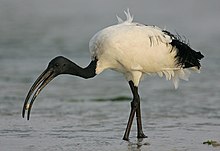African sacred ibis
| African sacred ibis | |
|---|---|
 |
|
| Foraging in Mida Creek mud flats, Kenya | |
| Scientific classification | |
| Kingdom: | Animalia |
| Phylum: | Chordata |
| Class: | Aves |
| Order: | Pelecaniformes |
| Family: | Threskiornithidae |
| Subfamily: | Threskiornithinae |
| Genus: | Threskiornis |
| Species: | T. aethiopicus |
| Binomial name | |
|
Threskiornis aethiopicus (Latham, 1790) |
|
 |
|
| Natural Range of T. aethiopicus | |
The African sacred ibis (Threskiornis aethiopicus) is a species of ibis. Its sister species is the Australian white ibis.
An adult individual is 68 cm (27 in) long with all-white body plumage apart from dark plumes on the rump. The bald head and neck, thick curved bill and legs are black. The white wings show a black rear border in flight. Sexes are similar, but juveniles have dirty white plumage, a smaller bill and some feathering on the neck.
This bird is usually silent, but occasionally makes some croaking noises, unlike its vocal relative, the hadada ibis.
A wading bird of the ibis family, Threskiornithidae, the sacred ibis breeds in Sub-Saharan Africa, southeastern Iraq, and formerly in Egypt, where it was venerated and often mummified as a symbol of the god Thoth. The African sacred ibis occurs in marshy wetlands and mud flats, both inland and on the coast. It will also visit cultivation and rubbish dumps.
The bird nests in tree colonies, often with other large wading birds such as herons. It builds a stick nest, often in a baobab tree and lays two or three eggs.
It feeds on various fish, frogs, small mammals, reptiles and smaller birds as well as insects. It may also probe into the soil with its long bill for invertebrates such as earthworms.
The African sacred ibis has been introduced into France, Italy, Spain, Taiwan, and Bahrain.
The introduced and rapidly growing populations in southern Europe are seen as a potential problem, since these large predators can devastate breeding colonies of species such as terns. They also compete successfully for nest sites with cattle and little egrets. The adaptable ibises supplement their diet by feeding at rubbish tips, which helps them to survive the winter in these temperate regions.
...
Wikipedia

